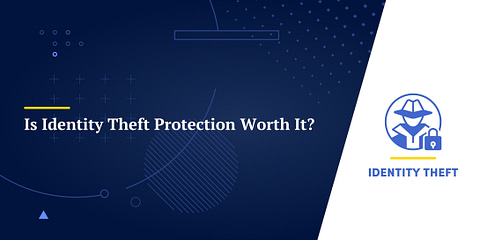Identity theft is a huge problem in the US. These identity theft statistics reveal just how big of a problem it is, and who is most affected.
Most people may think that identity theft is rare. Unfortunately, the data shows the contrary. Identity theft happens both more often and in more ways than most people presume.
The data here should help you understand how prevalent identity theft is, who are the most likely targets, and how you can protect yourself.
Key Findings
- In 2022 alone, 1,107,209 Americans reported identity theft.
- Identity fraud damages suffered by U.S consumers reached $43 billion (USD).
- 27% of all ID theft cases during the COVID pandemic involved Government Documents or Benefits Fraud.
- Georgia leads the way as the state with most cases of identity theft.
- People ages 30 to 39 are most likely to get their identities stolen.
- 51% of victims of identity theft had an annual income of $75,000 or more.
- Caucasians made up 71% of all identity theft victims.
- 14% of the victims report they have lost more than $10,000 due to identity theft.
How Common is Identity Theft?
In 2022 there were 1,107,209 instances of identity theft reported by the Consumer Sentinel Network.[1]✓
✓ Trusted source
Consumer Sentinel Network
Consumer Sentinel Network is a complaint database that stores information about fraud, identity theft, telemarketing, and other consumer-related complaints.
To get a sense of scale, that would mean that 1 in 200 Americans has filed an identity theft report.

Types of Identity Theft
The data from 2022 show that the leading cause of identity theft in the US is credit card fraud.
The most common causes of identity theft in 2022:
Historical data shows that government documents and benefits fraud saw a major increase during the pandemic. The reason for this is that criminals started using stolen or fake identities to obtain pandemic benefits illegally.
Identity theft reports by category (2018-2022):
Victims of Identity Theft
In the following section, we take a look at where in the US identity theft is most common and which segments of the population are most likely to fall victim.
Identity Theft By State
Georgia registered the highest number of identity theft reports per 100k inhabitants, having 60,348 reports filed over the course of a single year.
Puerto Rico is the state with the lowest number of identity theft reports per 100k inhabitants, with only 1,537 reports.[2]
Identity Theft By Age
People ages 30 to 39 are most likely to get their identities stolen, followed by 40 to 49-year-olds.[2]
This could be due to the fact that by that age most people already have a stable job and a higher income. Their identity details are used more often and are more vulnerable to theft and more attractive to thieves.
People over 60, as well as those under 19 years of age, are least likely to fall victim to identity theft.
Identity Theft By Income
A bulletin published by the Bureau of Justice Statistics shows that 51% of victims of identity theft had an annual income of $75,000 or more.[3]✓
✓ Trusted source
Bureau of Justice Statistics
The Bureau of Justice Statistics is the primary federal agency in charge of monitoring crime and the administration of criminal and civil justice systems.
People with an annual income of $24,999 or less accounted for 12% of the victims.
Identity Theft By Gender
Gender does not seem to be a key factor when identity thieves choose their victims. Males (48%) and females (52%) are almost equally likely to be victims of identity theft.[3]
Identity Theft By Race
White communities reported identity theft incidents the most, making up 71% of all identity theft victims, with indigenous and multiracial persons being the least ethnic groups to report these incidents.[3]
Let’s compare those figures to the same groups as a percentage of the population.
| Race | Percent of Population | Percent of Identity Theft Victims |
|---|---|---|
| White | 60.1% | 71.44% |
| Black | 13.4% | 9.06% |
| Hispanic | 18.5% | 11.73% |
| Asian | 5.9% | 5.15% |
| Other | 2.1% | 2.63% |
These figures indicate that whites are slightly more likely to be targeted by identity thieves. This may be because the white population tends to be more affluent, and as we established earlier, 51% of victims of identity theft had an annual income of $75,000 or more.
It is not clear whether identity thieves are deliberately targeting more affluent individuals or more affluent individuals are simply more active in credit markets, leaving their identifying information more exposed.
The Financial Impact of Identity Theft
In 2022, overall identity fraud damages suffered by U.S consumers reached $8.8 billion (USD). Unfortunately, the numbers seem to increase year by year as identity thieves come up with new ways of scamming their victims.[4]
The majority of victims will lose up to $100, but 14% of the victims lost more than $10,000 as a result of identity theft.[4]
If we take into consideration the total number of reports, that means that the average loss occurring as a result of identity theft is around $650 per victim.
Prevention and Resolution
Catching identity theft early on can significantly reduce the damage from your information being exposed. There are countless ways for thieves to get hold of your information so make sure you know how to detect signs of identity theft and what to do about it if it happens.
What People Do to Prevent Identity Theft
According to a report by the Bureau of Justice Statistics, the most common measures people take in order to prevent ID theft are checking their bank and credit card statements as well as destroying documents with personal information.[3]✓
✓ Trusted source
Bureau of Justice Statistics
The Bureau of Justice Statistics is the primary federal agency in charge of monitoring crime, criminal victimization, criminal offenders, crime victims, crime correlates, and the administration of criminal and civil justice systems at the federal, state, tribal, and municipal levels.
Only 9% of respondents reported paying for any type of identity theft protection service such as LifeLock by Norton. These services are commonly used by people who are at high risk or who believe their identities have already been compromised.
How Long It Takes to Fix the Issue
More than half (55%) of the victims managed to resolve the financial and credit problems associated with their identity being stolen in 1 day or less.
Victims of the misuse of one type of existing account were more likely to solve the problems within one day after reporting the incident (57%) than the victims with multiple accounts affected.[3]
Identity theft is a common and growing problem, and identity thieves are constantly looking for new ways to steal personal information. Knowledge and awareness are the keys to protecting yourself and limiting the damage if you are targeted.
📘 Check out our article “12 Essential Steps to Prevent Identity Theft” if you want to learn more about it.
FAQ:
The first thing would be to report the identity theft to The Federal Trade Commission. After that you have to notify your financial service provider about the incident. Make sure you have an account statement or bill with you when you call.
To prevent identity theft from happening, check your bank and credit card statements regularly, make sure to destroy all your documents containing personal information before discarding them and use Two-Factor Authentication to prevent your data from being stolen.
To see if you’re a victim of identity theft, check your credit card or bank account statements for unauthorized account activity or for unfamiliar accounts in credit reports.
A thief who has as little as your name and Social Security number in their possession can access your accounts and can even apply for credit in your name. That is why we strongly recommend checking your documents regularly and taking additional steps to prevent identity theft.
To lock your Social Security Number, you can call the National 800 number and ask to Block Electronic Access. (Toll-Free 1-800-772-1213 or at their TTY number at 1-800-325-0778).












